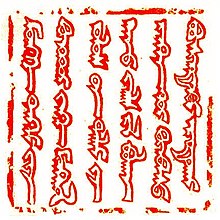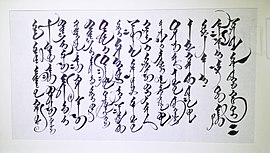Mongolian calligraphy


| Part of a series on |
| Calligraphy |
|---|
 |
Mongolian calligraphy is a kind of calligraphy of the Mongolian people of Central Asia. Like most other calligraphies in East Asia (e.g. Chinese calligraphy and other calligraphic techniques root from Chinese calligraphy, such as Korean calligraphy and Japanese calligraphy) it is mostly done with a brush. [citation needed][1]
Although the Mongolian language in Mongolia uses a Cyrillic orthography adopted during the Communist era, Mongolian calligraphy is written in the traditional Mongolian bichig script. In 2013, Mongolian Calligraphy was inscribed on the UNESCO List of Intangible Cultural Heritage in Need of Urgent Safeguarding. At present, only three middle-aged scholars voluntarily train the small community of just over twenty young calligraphers. Traditionally, mentors select the best students and train them to be calligraphers over a period of five to eight years. Students and teachers bond for life and continue to stimulate each other’s artistic endeavours. The rate of social transformation, urbanization and globalization have led to a significant drop in the number of young calligraphers.[2]
- Gallery
References
- ^ "蒙古文书法 - 政协书画院 - 中国人民政治协商会议内蒙古自治区委员会". Nmgzx.gov.cn. 2011-03-23. Retrieved 2013-10-06.
- ^ "Mongolian Calligraphy". unesco.org. Retrieved 2016-01-07.









